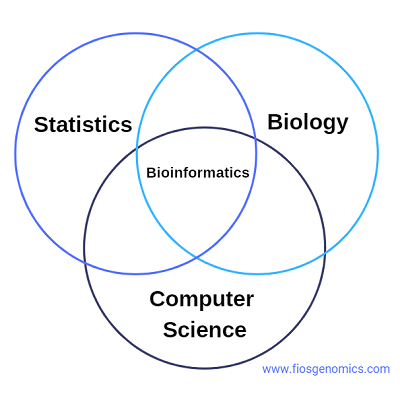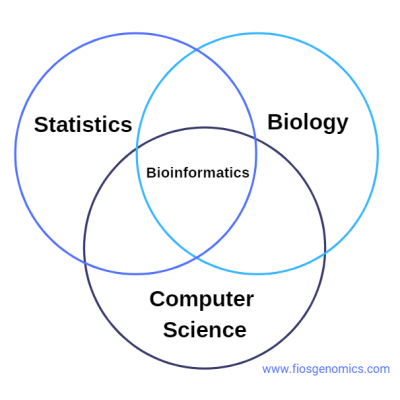What is Bioinformatics – Overview and Examples
- 16th August 2021
- Posted by: Breige McBride
- Category: Bioinformatics

Bioinformatics is essentially big data analysis for biological data sets. It requires computational and statistical analyses in order to extract meaning from biological data. Since this is the case, bioinformatics can also be used to refer to the development of the software and methods which are used to understand biological data. As you will now understand, bioinformatics is an interdisciplinary field where biology, computer science, and statistics meet.
The Components of Bioinformatics
The diagram below demonstrates that bioinformatics is where biology, computer science, and statistics intersect. We need knowledge of all three in order to fully explore the benefits of bioinformatics in your research.

Biology
The statistical analyses you conduct will have no biological basis if you do not have an understanding of biology. While it might be useful to know that the Treatment A group has results showing higher values of Protein X than the Treatment B group, you need biological knowledge to understand the pathways or genes that cause that result. Is it due to an up-regulation of a certain pathway? Moreover, is this result even significant in answering your research question? You may find that without the biological knowledge to interpret your results, you know an ending without explanation and also without the method and mechanism of action.
Computer Science
Without computer science, analysis speed would be significantly slower. Bioinformaticians write software to help automate analyses (instead of manually working through each one). Being able to combine hundreds of thousands of datapoints into analysis through coding allows for larger datasets to be created while still keeping the analysis time to a reasonable length. Depending on the size of the dataset, however, there can still be large computational time requirements, although it will be much reduced compared to a non-bioinformatic approach.
Statistics
In short, without statistics, there would be no in-depth analysis. Basic graphs may show that Treatment A has results with higher values of Protein X than Treatment B, but the actual significance of these results would be unknown. For example, is there a significant difference between A and B, or does it just look that way from the graph? New treatments need solid evidence behind them for approval and statistical analyses can prove the true benefits of a treatment.
Who Invented Bioinformatics?
Paulien Hogeweg and Ben Hesper first coined the term ‘bioinformatics’ in the early 1970s and defined it as ‘the study of informatic processes in biotic systems’¹. However, before the term was coined the stage was set for bioinformatics to emerge as a new field of study in the 1960s when computational methods were applied to protein sequence analysis by Margaret Dayhoff. In fact, Dayhoff has been referred to as ‘the mother and father of bioinformatics’².
What is Bioinformatics Used For?
The field of bioinformatics has advanced considerably in the 50 years since the term was first coined. It has evolved to keep up with progress in molecular biology and computer science. The rise of the internet in the 1990s coupled with the creation of next-generation sequencing (NGS) technologies in the 2000s created a boom in the availability of biological data to be analysed. In turn, this led to the swift production of new bioinformatics tools.³
Nowadays, we can apply bioinformatic analyses to various biological data sets such as:
- Genome Sequence Data
- Gene Variation Data
- Gene Expression Data
- Single-Cell Data
- Proteomics Data
- Metabolomics Data
- Epigenetics Data
Additionally, we can also apply bioinformatic analyses to microarray data and flow cytometry data. Bioinformatics allows for mining of public databases as well, to find genes or pathways that could potentially be of interest for future research directions.
Since the data sets above are widely used in therapeutic research, there are a number of therapeutic research areas which benefit from bioinformatic analysis. These include oncology, cardiovascular and metabolic diseases, gastrointestinal research, infections and vaccines, respiratory research, dermatology, rare diseases and CNS research. In addition, agricultural and environmental research can also benefit from bioinformatics analysis.
What are Examples of Bioinformatics?
If you are wondering what the output of bioinformatics analysis looks like, then these examples will help. Our first example is a video walkthrough of a bioinformatics analysis report for analysis (RNA expression profiling) that we performed on genome sequence data relating to psoriatic skin under the action of an AhR agonist and antagonist.
Bioinformatics Report Walk-through Video
You can find further examples of bioinformatics being used in research by visiting our case studies and publications pages.
What Is A Bioinformatician?
If you develop bioinformatic approaches or perform bioinformatics analysis as a career, you are a bioinformatician. Since bioinformatics exists at the intersection of biology, computer science and statistics, bioinformaticians can come from each of these backgrounds. However, bioinformaticians working in drug development require a strong understanding of biology in order to understand the biological data that they are analysing and to communicate the results of the analyses.
If you would like to learn more about being a bioinformatician you can read our bioinformatician spotlight blogs where Fios bioinformaticians discuss their careers, how they became bioinformaticians and what it is like working at Fios Genomics.
Considering Bioinformatics Analysis for Your Research?
At Fios Genomics, we provide a wide range of bioinformatics services for a variety of applications. We create bespoke reports especially for each client, meaning there is not an ‘off-the-shelf’ version that we apply to all. Not only are our reports interactive, all the figures they include can also be downloaded as either PDFs or PNGs, and all tables can be downloaded in tabular data formats. This is to facilitate sharing of key results in alternative formats such as presentations and posters.
We work with all sizes of companies and organisations, academic as well as commercial. In fact, Fios can act as an extension for in-house bioinformatics resources or you can turn to us when internal bottlenecks need external solutions. Above all, we ensure that you uncover the deepest insights that your data can provide. If you would like to know how our analysis services could benefit your research project then please contact us. We will be happy to discuss your research, advise on the available analyses and provide a sample analysis report relevant to your research area.
Not ready to contact us yet? You can learn more about our experience working with projects similar to yours by visiting our publications page. You can also discover what our previous clients have to say about working with us by visiting our clients and partners page.
Need more information about what bioinformatic analysis involves? We have explained each of the steps in a bioinformatics project on our blog.
Author: Breige McBride, Content and Social Media Manager, Fios Genomics
Reviewed by Fios Genomics Bioinformatics Experts to ensure accuracy
Further Reading
Cancer Bioinformatics: Data Analysis for Oncology Research
Bioinformatics in Preclinical Development
Fios Genomics Bioinformatics Services
Science, Medicine and the Future: Bioinformatics
Bioinformatics – National Human Genome Research Institute
Sources
(¹) PLOS Computational Biology, https://journals.plos.org/ploscompbiol/article?id=10.1371/journal.pcbi.1002021, Accessed August 2021
(²) Briefings in Bioinformatics, https://academic.oup.com/bib/article/20/6/1981/5066445, Accessed August 2021
(³) Briefings in Bioinformatics, https://academic.oup.com/bib/article/20/6/1981/5066445, Accessed August 2021
Download RNASeq Data Analysis Report
Fill in the form below to access the data analysis report our team created. Here, bioinformatics analysis of publicly available RNA sequencing (RNASeq) datasets helped to identify genes and pathways associated with psoriasis and the response of psoriatic skin to modulation of the AhR.
Leave a Reply
You must be logged in to post a comment.

